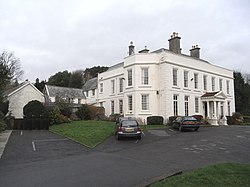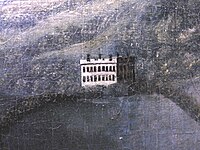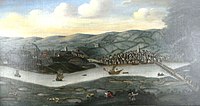Pilton House, Pilton
| Pilton House | |
| Devon | |
|---|---|
 Pilton House | |
| Location | |
| Grid reference: | SS55753404 |
| Location: | 51°5’15"N, 4°3’40"W |
| Town: | Barnstaple |
| History | |
| Built 1746 | |
| For: | Robert Incledon |
| Country house | |
| Information | |
| Owned by: | Barnstaple Old People's Housing Association |
Pilton House in the parish of Pilton, near Barnstaple in northern Devon is a historic Georgian mansion house, built in 1746 by Robert Incledon (1676-1758), twice Mayor of Barnstaple, who was from nearby Braunton. It stands almost in the centre of the ancient town of Pilton, but had formerly extensive grounds covering at least 20 acres, which extended down "Pilton Lawn", now built over, to the River Yeo.
The house was the residence for various Members of Parliament for Barnstaple, for which it was well suited being only a ten-minute walk from the centre of that town, yet in a secluded situation with extensive grounds, and sufficiently large and grand for entertaining borough officials and electors.
It is today a Grade II listed building,[1] and since shortly after the War it as served as a retirement home.

History
No record detailing the history of the site of Pilton House before the 18th century survives on available title deeds.[2] It is believed to occupy the site of the demolished mediæval Pilton Priory.[3] Reed (1985) states that the site was part of the Pilton Priory lands purchased by George Rolle (d.1552) of Stevenstone following the Dissolution of the Monasteries.[2] Rolle was the founder of the influential and wealthy Rolle family. The lands were quickly re-sold by him in 1545 piecemeal and at a profit.[4]

Robert Incledon (1676-1758) built Pilton House in 1746. He was a barrister, of New Inn, London, Clerk of the Peace and Deputy Recorder of Barnstaple[5] and twice Mayor of Barnstaple, in 1712 and 1721.[6] He was a member of the local ancient gentry family
In 1806, Robert Newton Incledon sold Pilton House to James Whyte and built for himself a new country residence at Yeotown,[2] (of which today only a castellated lodge with two square towers and a crenellated bow-window survives).[7]
James Whyte, who purchased Pilton House in 1806, expanded the estate by purchasing part of Pilton Lawn, which had been retained by the Rolle family. He also acquired Westaway House within the parish from Sir Thomas Buckler Lethbridge (1778–1849). Whytes Lane, formerly Ratton Row, in Pilton, was named after him.[8] In 1849, beset by financial difficulties, he put the estate up for sale, Pilton House being then described as:[2]
"Capital mansion house, offices, coach-house, stabling, lawn, pleasure grounds, gardens, conservatory, fountain and plantations with lodge entrance in Pilton Street, containing approximately 20 acres"
He sold at the same time Westaway House and farm, comprising 42 acres and 40 houses, cottages and gardens with the public house "The Priory Arms", fishing rights in the River Yeo and various other lands amounting to about 137 acres.[2]
The next owner was Sir William Fraser, 4th Baronet (1826-1898), a politician, author and book collector.[9] He was elected Member of Parliament for Barnstaple in 1852 (later to be unseated following a public enquiry into bribery). He was elected again in 1857 and in 1863 (though this time for Ludlow in Shropshire) and 1894 (for Kidderminster in Warwickshire).
Later Pilton House was the residence of Charles Henry Williams (later known as Charles Henry Basset, from 1880), who also served as Member of Parliament for Barnstaple. A later occupier, in 1893, was Major General Hugh Chichester (1836-1896) of the Royal Bengal Artillery. Major Chichester's great-grandmother was Amy Incledon, eldest daughter of the builder of Pilton House.
In 1948 the estate was acquired by the Barnstaple Old People's Housing Association.
Outside links
| ("Wikimedia Commons" has material about Pilton House, Pilton) |
References
- ↑ Pilton House, Barnstaple - British Listed Buildings
- ↑ 2.0 2.1 2.2 2.3 2.4 Reed, p.143
- ↑ Risdon, Tristram (d.1640), Survey of Devon, 1811 edition, London, 1811, with 1810 Additions, p.428 [1]
- ↑ Reed, pp.49-52, 143
- ↑ Vivian, 1895, p.498
- ↑ Lamplugh, Lois, Barnstaple: Town on the Taw, South Molton, 2002, p.15
- ↑ Pevsner, p.458
- ↑ Reed, p.24
- ↑ Reed, p.144
- Reed, Margaret A., Pilton: Its Past and Its People, Barnstaple, 1985
- Burke's Genealogical and Heraldic History of the Landed Gentry, 15th Edition, ed. Pirie-Gordon, H., London, 1937, pp. 2390–1, pedigree of Incledon-Webber of Buckland
- Vivian, Lt.Col. J.L., (Ed.) The Visitations of the County of Devon: Comprising the Heralds' Visitations of 1531, 1564 & 1620, Exeter, 1895, pp. 497–9, pedigree of Incledon of Buckland
- Nikolaus Pevsner: The Buildings of England: Devon, 1952; 1989 Penguin Books ISBN 978-0-300-09596-8
